Thermal Energy Teaching Resources
Teaching about thermal energy just got easier! Download printable worksheets, hands-on activities and Google Slide templates — created by teachers for science teachers and their lesson plans!
This collection of NGSS curriculum-aligned resources includes editable options and resources that our teacher team has already differentiated for you to make teaching about this type of energy a whole lot easier. Explore heat and how it is transferred, and dive into the meaning of temperature!
Each resource has undergone rigorous review by a Teach Starter teacher team member to ensure it's ready for use in your classroom.
Whether it's your first year covering thermal energy in the classroom or you're just looking for some new ideas, we have you covered! Read on for a primer from our teacher team, including a thermal energy definition and some examples you can use with your students.
What Is Thermal Energy? A Kid-Friendly Definition
So what exactly is thermal energy, and how do you explain it to kids? Here's a definition you can add to your lesson plans!
Thermal energy is the internal energy of a substance. This energy comes from the way the atoms and molecules in the substance or object move and interact with one another.
When molecules move faster, they have more thermal energy. When they move slower, they have less.
Thermal Energy and Temperature
Thermal energy is directly related to the temperature of an object or substance.
- When the temperature increases, so does its thermal energy!
- When the temperature decreases, the thermal energy decreases too.
What Are Kinetic Energy and Potential Energy? Kid-Friendly Definitions
Thermal energy is made up of a mix of the total kinetic energy of the molecules in a particular substance plus their potential energy.
With that in mind, we've got a simple kinetic energy definition and a definition of potential energy that you can use as well.
Kinetic Energy
Kinetic energy is the energy an object possesses due to its motion. In the case of thermal energy, it's the motion of the molecules that provides the kinetc energy component of thermal energy.
- The formula for kinetic energy is KE = 1/2 * mass * velocity^2.
Potential Energy
Potential energy is the energy stored in an object due to its position or condition. When potential energy is released, it can be transformed into thermal energy.
Thermal Energy vs. Heat Energy — What's the Difference?
We can't talk about thermal energy in science class without talking about heat.
Heat is something that makes things warm or hot, and heat can cause changes in thermal energy.
So are thermal energy and heat energy the same thing? Not quite!
- Heat energy specifically refers to the transfer of energy from a region of higher temperature to a region of lower temperature.
- Thermal energy, on the other hand, represents the overall energy content of a system.
How Is Thermal Energy Transferred?
If you've ever touched a dish that is still warm from the oven with your bare hand, you've experienced how thermal energy can transfer from one object to another.
There are three main ways that this can occur:
Conduction Heat Transfer
Conduction heat transfer is a transfer of heat from an area of higher temperature to an area of lower temperature — essentially from a warmer end to a cooler end.
When you touch a hot pan out of the oven, heat is conducted from the dish to your hand. If you place a piece of ice in your hand, it will start to melt as heat from the body transfers to the ice.
Convection Heat Transfer
Convection is another method of heat transfer, but this type occurs through the movement of liquids or gases. Convection happens when warmer, less dense substances rise, and cooler, denser substances sink.
A good example of convection that can be demonstrated right in the classroom with the help of a Bunsen burner is boiling water.
When a pot of water boils, the hotter water rises. Meanwhile, the cooler water sinks. This creates a convection current.
Radiation Heat Transfer
The final method of heat transfer is called radiation. This term refers to the transfer of energy through electromagnetic waves.
For example, if you place your hand near a burning candle, you may feel the heat through radiation. We also feel the heat of the sun through radiation.
- Plus Plan

What Is Conduction? - PowerPoint Presentation
Use this introduction to thermal conductivity lesson to explain to your students the properties of matter and the transfer of energy.
- Free Plan

Does the Sun Transfer Heat? – Science Experiment
Discover how the sun transfers thermal energy and which objects absorb more heat with this science experiment for kids.
- Plus Plan

Observing Conduction Science Experiment
Teach students to make predictions about and observe thermal energy transfer through this conduction experiment.
- Free Plan
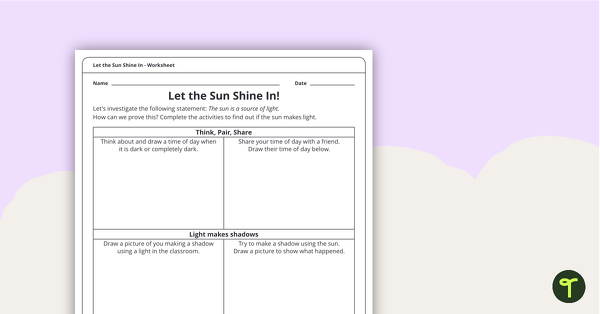
Let the Sun Shine In! - Worksheet
A worksheet to use when exploring the sun as a light source.
- Plus Plan

Heat Sources Sorting Activity
Explore various sources of heat and how they are produced with this printable Heat Energy Sorting activity.
- Plus Plan

Labeling Transverse & Longitudinal Waves Worksheet Pack
Label parts of a wave with a Transverse and Longitudinal Waves Worksheet Pack.
- Plus Plan
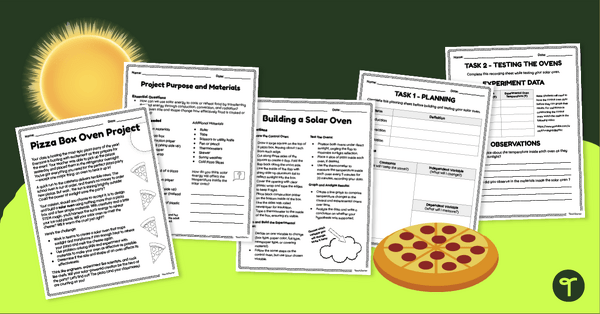
Build a Pizza Box Oven - Solar Energy STEM Project
Build a pizza box solar oven to demonstrate the power of thermal energy with an exciting Solar Oven Stem Project
- Plus Plan

Sources of Heat Teaching Slides
Learn about the different sources of heat with this set of engaging teaching slides.
- Plus Plan

Conductors and Insulators Teaching Slides
Teach your students about insulators and conductors of thermal and electrical energy with this set of teaching slides.
- Plus Plan

Heat Energy Sources Interactive Activity
Help students identify different sources of heat energy with this engaging, interactive activity.
- Plus Plan

Heat Energy Vocabulary Match Up Activity
Explore different heat energy vocabulary words with this definition and word match-up activity.
- Plus Plan

Wheel of Heat Transfer Project
Explore the process of heat transfer with this engaging wheel of heat project.
- Plus Plan

Natural and Human Made Heat Sources Sort
Explore the different man-made and natural heat sources with this sorting activity.
- Plus Plan

Heat Transfer Posters
Display these posters to check understanding or reinforce the teaching and learning of how heat energy transfers.
- Plus Plan
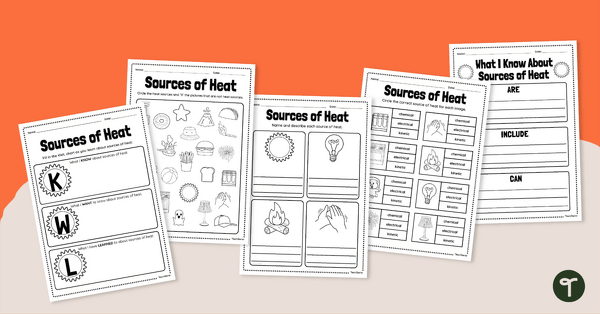
Sources of Heat Worksheet Pack
Learn all about different thermal energy sources with this set of heat worksheets.
- Plus Plan
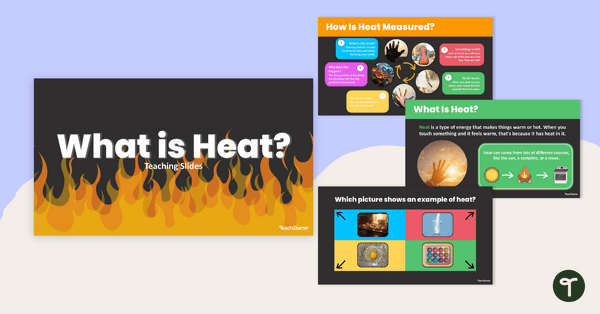
What is Heat? Thermal Energy Teaching Slides
Guide students through learning about thermal energy with this set of ‘What is Heat?’ teaching slides.
- Plus Plan
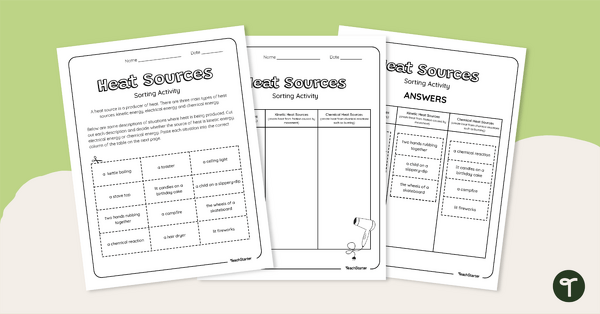
Heat Sources Cut-and-Paste Worksheet
Explore different types of heat sources with your students using this cut-and-paste worksheet.
- Plus Plan
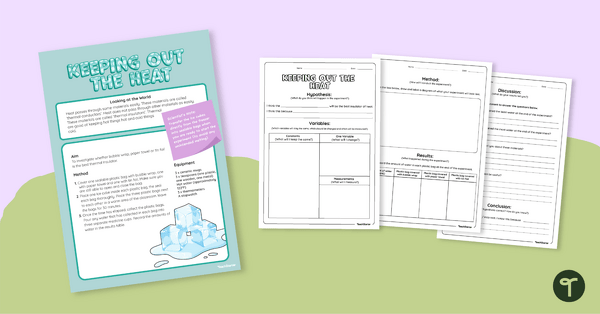
Heat Insulators Science Experiment (Keeping Out the Heat)
Investigate heat insulators with your students using this engaging science experiment.
- Plus Plan

Thermal Conductors and Insulators Sorting Worksheet
Explore materials and everyday items as heat conductors or heat insulators during your heat energy unit with this cut-and paste worksheet.
- Plus Plan

What is Heat? Poster
Explore the concept of heat energy with this classroom poster.
- Plus Plan

Heat Conductors Science Experiment (Feel the Heat)
Investigate heat conductors with your students using this engaging science experiment.
- Plus Plan

Heat Sources Poster Set
Display these heat sources posters during your heat energy science unit.
- Plus Plan

Thermal Energy Word Wall Vocabulary
Explore heat energy vocabulary with this set of thermal energy vocabulary cards.
- Plus Plan

Thermal Energy Movement Teaching Slides
Explore thermal energy, the movement of particles, and the effect on the state of matter with your students using these teaching slides and guided notes.
- Plus Plan

Conductors and Insulators Worksheet
Use this insulators and conductors worksheet with your students to practice identifying the characteristics of thermal and electrical energy.
- Plus Plan

Forms of Energy – Science Experiments for Kids
Investigate mechanical, electrical, light, thermal, and sound energy with this set of science activities for kids.
- Plus Plan

Energy of the Sun Worksheet
Investigate and record the amount of energy from the sun with this science experiment for kids.
- Plus Plan
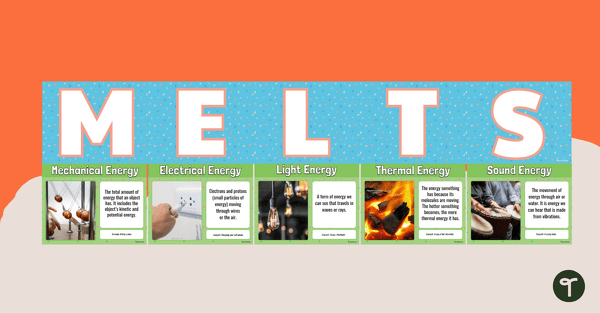
Forms of Energy Poster Pack
Display information about mechanical, electrical, light, thermal and sound energy with this poster pack.
- Plus Plan
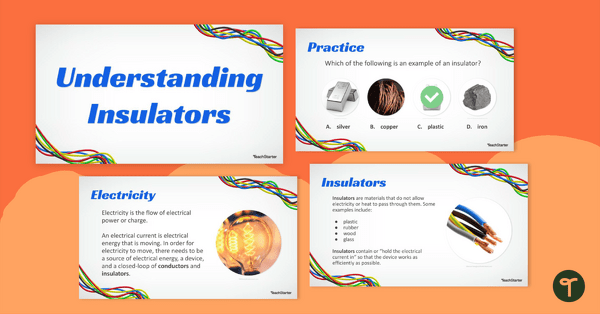
Understanding Insulators Teaching Slides
Teach your students about electrical and thermal insulators with this teaching presentation.
- Free Plan

Insulators and Conductors Worksheet
Identify different insulators and conductors of thermal and electrical energy with this worksheet.
- Plus Plan

Heat Transfer Worksheet
A worksheet to practice identifying the methods of heat transfer.
- Plus Plan

Thermal Energy Transfer Sorting Activity
Learn about conduction, convection, and radiation with this set of 24 sorting cards.